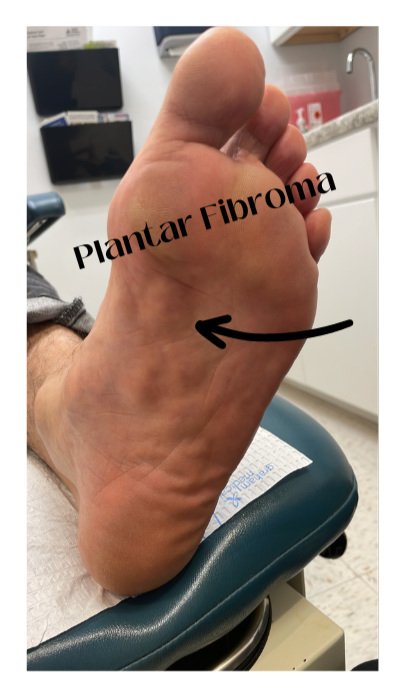Plantar Fibromas: Symptoms, Causes, and Treatment
What are Plantar Fibromas?
Plantar fibromas are benign, non-cancerous growths that develop in the plantar fascia, the thick band of tissue that runs along the bottom of the foot. These growths are usually slow-growing and can vary in size.
Symptoms of Plantar Fibromas
Pain: The most common symptom of plantar fibromas is localized pain in the arch or heel of the foot. The pain can range from mild discomfort to sharp, intense pain, especially when standing, walking, or wearing tight shoes.
Palpable Lump: You may feel a firm lump or nodule under the skin of the foot, typically located in the arch area.
Limited Mobility: Some individuals may have trouble flexing the affected foot due to the presence of the fibroma.
Causes of Plantar Fibromas
While the exact cause of plantar fibromas is not fully understood, several factors may contribute to their development:
Genetics: There's evidence suggesting a genetic predisposition to developing plantar fibromas, with a higher likelihood if there's a family history of plantar fibromas, Dupuytren’s contracture or Peyronies’ disease.
Trauma: Repetitive trauma or injury to the plantar fascia, often due to activities that put stress on the foot, can increase the risk of fibroma formation.
Foot Structure: Abnormal foot mechanics, such as flat feet or high arches, can contribute to the development of plantar fibromas.
Age: Plantar fibromas are more common in middle-aged and older adults.
Treatment Options
At Lighthouse Foot and Ankle we offer comprehensive and personalized treatment options to address plantar fibromas and alleviate your discomfort. Our experienced podiatrist will work closely with you to determine the best approach for your individual case.
Non-Surgical Treatments
Topical Medication: A medication commonly used to treat heart conditions has been discovered by doctors to have potential benefits when applied topically (on the skin) for managing plantar fibromas. When applied directly to the affected area, this medication helps to break down the excess collagen that forms the fibromas. This can help reduce the size and discomfort of the lumps over time. The topical application is generally painless and can be a less invasive option compared to some other treatments. It is best to start this treatment when the lesions are small. You need to consistently apply the medication in order for it to be effective and may take up to 6 months to see results.
Steroid Injections: Steroid injections involve injecting a corticosteroid medication directly into the fibroma. These injections work to reduce inflammation and temporarily shrink the size of the lump. While steroid injections can provide relief from pain and discomfort, it's important to note that the effects may be temporary, and multiple injections might be needed over time. This option is commonly used when fibroma is causing significant pain and hindering daily activities.
Enzyme Injections: Enzyme injections involve injecting specific enzymes into the fibroma. These enzymes help break down the excess collagen that makes up the lump. The goal is to gradually decrease the size of the fibroma and relieve symptoms. Enzyme injections are a relatively newer treatment option and might be considered when other treatments such as topical treatments and steroid injections haven't provided the desired results. Injections are typically done 3 weeks apart. Patients may need between 2 to 6 injections to achieve the desired results.
Orthotics: Orthotics are specially designed shoe inserts that can help redistribute pressure on the foot and provide better support. For people with plantar fibromas, orthotics can help alleviate discomfort by reducing the pressure on the lumps and providing better cushioning. They can also help improve foot mechanics, which might contribute to the development of fibromas in the first place. Orthotics are a conservative treatment option that is used in combination with other treatments.
Tenex Procedure: The Tenex procedure is a minimally invasive treatment that involves using ultrasound technology to guide a tiny instrument into the fibroma. This instrument uses high-frequency vibrations to break down the fibrous tissue. The broken-down tissue is then removed through a small incision. The Tenex procedure aims to remove the fibroma while minimizing damage to surrounding healthy tissue. This procedure is considered when other treatments have not been successful or when the fibroma is particularly large.
Each of these treatment options has its own benefits and considerations, and the choice of treatment will depend on factors such as the size of the fibroma, the level of discomfort it causes, and the individual's overall health. We typically recommend combination therapy; orthotics, and topicals to start and injections for more painful lesions. The sooner you start treatment the better the outcomes. It's important to consult a healthcare professional, preferably a podiatrist, to determine the most suitable treatment approach for your specific situation.
Schedule a Consultation
If you're experiencing pain or discomfort in your feet and suspect you might have a plantar fibroma, don't hesitate to reach out to us. We are here to provide expert diagnosis, personalized treatment plans, and compassionate care.
Contact us today to schedule a consultation and take the first step toward healthier, pain-free feet.






